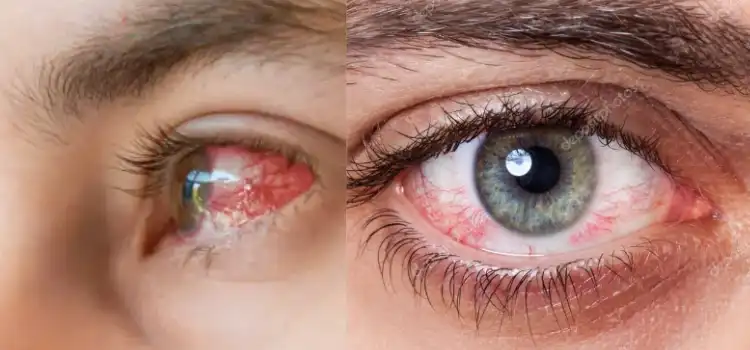Eye infection happens when harmful microorganisms, such as bacteria or viruses, fungi spread to any part of the eye or the surrounding area. It is a common medical issue for people of all ages. Eye disease has different symptoms such as mild discomfort, severe pain, redness, and even vision loss. Ocular infections affect various parts of the eye, including the eyelid, cornea, or conjunctiva. Conjunctivitis is the most common eye disease. Some infections are treatable; some can lead to complications if left untreated. Eye infections cause frequent visits to primary care.

What is eye infection?
Eye infections are common conditions affecting different parts of the eye. They include conjunctivitis (pink eye), keratitis, styes, blepharitis, and uveitis. Symptoms often include redness, swelling, pain, discharge, blurred vision, and sometimes blindness. Causes of eye disorders range from bacteria and viruses to fungi and allergens. Treatment varies but often involves eye drops, antibiotics, or antifungal medications. Preventing infections involves good hygiene and avoiding contaminated contact lenses. Risk factors include weakened immune systems, poor vision, trauma to the eye, discomfort, and blindness in some cases. Complications can arise if left untreated. Always consult a doctor when symptoms worsen or persist.
Types of eye infections
There are several types of eye infections, caused by different factors, each affecting different parts of the eye. The most common include:
- Conjunctivitis (Pink Eye)
- Keratitis
- Stye
- Blepharitis
- Uveitis
Conjunctivitis (Pink Eye)
Conjunctivitis, also known as pink eye, is an inflammation or infection of the conjunctiva—the clear layer that covers the white part of your eye and lines your eyelids. It occurs when blood vessels in the conjunctiva are infected with a virus or bacteria. It leads to redness, itching, and discharge that can cause the eye to feel sticky, mostly in the morning. Conjunctivitis can spread even two weeks after contracting the infection.
Pink eye caused by infection is highly contagious. Bacteria, viruses, or allergens can be the cause. Bacterial conjunctivitis can be treated with antibiotics such as eye drops, ointments, or drugs. While conjunctivitis caused by a virus usually fades away on its own after some days. On the other hand, allergic conjunctivitis is treated with over-the-counter antihistamines.
Keratitis
Keratitis is an inflammation of the cornea due to viral, bacterial, and fungal infection. It is common with individuals that wear contact lenses—especially if they don’t clean their lenses properly or wear them overnight and have a weakened immune system from another illness. Symptoms of keratitis include swelling and redness of the eyes, eye pain or discomfort, increased tear production, blurred vision, and light sensitivity. Untreated keratitis can cause severe vision problems. Eye drops are mostly used for the treatment.
Stye
A stain is a small, painful bump or pimple that grows on the outer edges of the eyelid. These oil glands get clogged and allow bacteria to overgrow. It happens when an oil gland or hair follicle becomes infected, mostly because of bacteria. Styes cause swelling and discomfort. They heal on their own within a week or more.
Applying warm compresses several times a day can enhance the healing process. Squeezing or popping a stye can spread the infection or make it complicated.
Some symptoms of styes are increased tear production and swelling, itchiness and irritation of the eyes, and pain. Over-the-counter pain relievers and antibiotic ointments can be used as treatments.
Blepharitis
Blepharitis is the inflammation of the eyelids, causing them to become red, swollen, and irritated. It occurs when oil glands at the base of the eyelashes get clogged, resulting in inflammation. Symptoms include itching, burning, and tearing of the eyes, especially during wakeup times. Keeping the eyes clean and using warm compresses to help unclog the oil glands can be used to manage blepharitis. Eye drops or ointments can also be used for the treatment.
Uveitis
Uveitis is the infection of the uvea that leads to inflammation of this part of the eyes. The uvea is the pigmented layer of the eye, which includes the iris and the choroid. It can be caused by infections, autoimmune diseases, or injuries. Symptoms include eye pain, blurred vision, redness, and sensitivity to light. Uveitis can be severe and can lead to permanent vision loss if left untreated.
Symptoms of eye infections
Symptoms of eye infections differ depending on the type and severity of the infection. These include:
- Red or swollen eye
- Pain or discomfort in the eye
- Watery or thick discharge from the eye
- Swollen eyelids
- Dry eyes
- Itching or burning sensations
- Blurred or reduced vision
- Light sensitivity
Causes of eye infections
Eye infection can be caused by the following:
- Bacteria: Our hands can transfer bacteria to our eyes. Also, contaminated surfaces or poorly used contact lenses can lead to infections like conjunctivitis or styes.
- Viruses: Conditions like viral conjunctivitis or keratitis are caused by viral infections, such as the common cold or herpes. They can spread to the eye.
- Fungi: Fungal spores from the environment can infect the eye, particularly after injury or exposure to contaminated water or soil, leading to fungal keratitis.
- Parasites: Parasites, like Acanthamoeba from contaminated water or lenses, can infect the eye. This is often seen in the communities of contact lens users.
- Allergies: Allergens like pollen, dust, or pet dander can trigger eye infections, especially allergic conjunctivitis.
- Chemical Exposure: Harsh chemicals, such as household cleaning agents or chlorine from pools, can irritate the eyes. Avoid them if possible.
- Foreign Objects: Dirt, debris, or small particles getting into the eye can cause irritation and infection if not removed promptly. Smoky environments are not exempt.
- Contact Lens Misuse: Wearing contaminated or improperly cleaned contact lenses can introduce germs, increasing the risk of infections.
- Injury or Trauma: Scratches or injuries to the eye can create openings for infections to develop.
Treatment of Eye Infections
Treatment for eye infections depends on the cause and severity of the infection. They include:
- Antibiotics are used to treat infections caused by bacteria. E.g., eye drops, ointments, or tablets. It takes 24-48 hours for antibacterial medications to be effective.
- Antiviral medications; herpes-related eye infections are treated using antiviral medication.
- Antifungal medications; antifungal treatments are used for fungal eye infection.
- Warm Compresses: Warm compresses help treat eye infections by increasing blood flow, reducing inflammation, and loosening clogged oil glands. You do this by applying a clean, warm cloth to the affected area. You can use it to treat conditions like styes or blepharitis.
- Using over-the-counter (OTC) pain relievers.
- Avoiding allergens that caused the eye infection.
Eye Infection Prevention
Preventing eye infections requires practicing good hygiene and protecting the eyes from harmful elements. Preventing every eye infection may not be easy, but taking some steps can reduce the risk of eye infections. Some steps include:
- Practice good hand hygiene.
- Clean contact lenses properly.
- Avoid sharing personal items, e.g., lenses. Eye makeup, towels, etc.
- Wear protective eyewear when exposed to dust, chemicals, or other irritants.
- Follow recommendations and directions on how to use your contact lenses.
- Avoiding allergens that bother your eyes and taking allergy medicine to prevent irritation.
- Discard cosmetics that caused an eye infection to avoid getting re-infected.
- Regular eye checkups
Risk Factors for Eye Infections
Certain factors can increase the risk of eye infection. Understanding these risk factors can help an individual take preventative measures. Some common risk factors are:
- Poor hygiene: This is the most common factor that causes eye infections. Poor hand hygiene, especially before touching the eyes or contact lenses, can introduce harmful microorganisms to the eye area, leading to infection. This also applies to not cleaning contact lenses and their cases correctly.
- Exposure to Harmful Substances: Frequent exposure to harmful environmental factors, such as chemicals, dust, or smoke, can irritate the eye and increase the risk of infections.
- Eye Trauma: Scratches or injuries to the eye can introduce harmful bacteria or fungi, leading to eye infection.
- Wearing contact lenses: extended wear of contact for a long period without proper care increases the chance of eye infections. Poor lens hygiene or using contaminated lens solutions is a risk factor for eye infection.
- Chronic Dry Eye: inflamed dry eyes can cause corneal ulcers, increasing the risk of infection.
- Weakened Immune System: individuals with weakened immune systems, e.g., diabetes, HIV/AIDS, are exposed to increased risk of eye infection.
Complications from Eye Infections
Eye infections can lead to various severe complications if left untreated; such complications can be vision-threatening. Some possible complications of eye infections are:
- Vision loss or blindness
- Corneal ulcers or perforation
- Cataract formation
- Endophthalmitis
- Retinal detachment
- Optic neuritis
- Orbital cellulitis
- Dry eye
When to See a Doctor
It’s important to see an eye care professional when:
- Symptoms persist and do not improve within a few days.
- Severe eye pain or a sudden loss of vision
- There is continuous discharge of thick, green, or yellow discharge from your eye.
- Increased sensitivity to light that worsens over time
- Double vision
- Eye swelling or severe redness
Eye Infection Overview
Eye infection happens when harmful microorganisms, such as bacteria or viruses, fungi spread to any part of the eye or the surrounding area. They can cause serious risks to the vision and eye health if left untreated. It is a medical issue in people of all ages. Conjunctivitis, keratitis, etc. are types of eye infection. Understanding the symptoms and seeking immediate medical care can help prevent complications. Some symptoms include mild discomfort, severe pain, redness, and even vision loss. Eye infections affect various parts of the eye, including the eyelid, cornea, or conjunctiva. By practicing good hygiene, cleaning and managing contact lens care, and avoiding environmental pollutants, you can reduce the risk of having an eye infection. In all, always consult an eye care professional for an eye examination and secure overall eye health.

Pingback: Hybrid Contact Lenses: Comfort, Vision Correction, Durability - Kaimacostmetics
Pingback: Scleral Contact Lenses - Kaimacostmetics